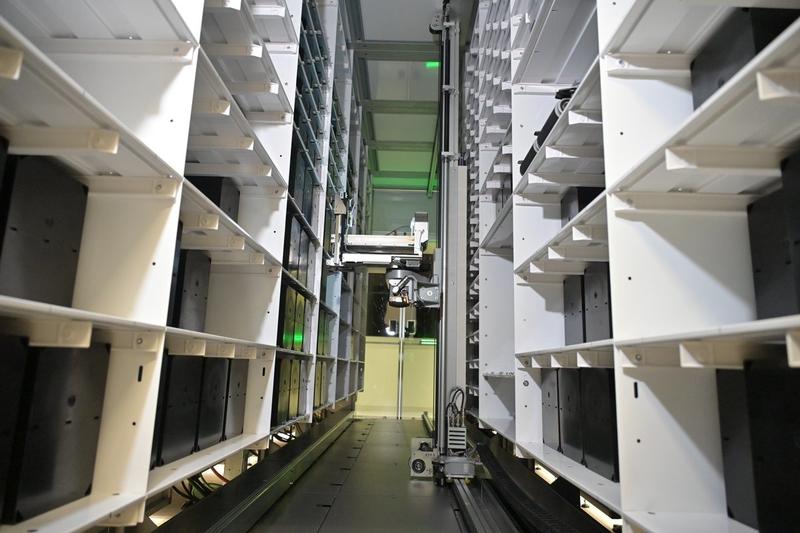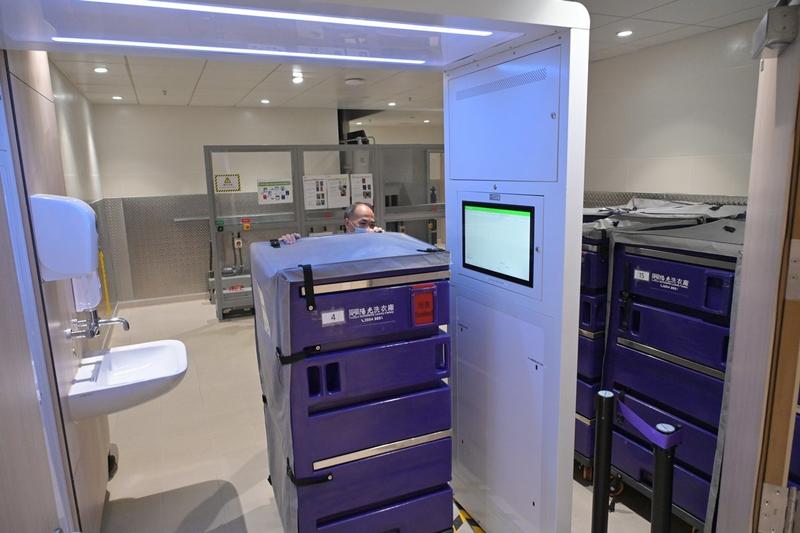 Healthcare staff use the Internet of Things-connected drug trolley E-Medcart by scanning a code on the patient’s wristband to verify the medication’s information and unlock the corresponding compartment on the trolley, reducing the risk of medication errors. (PHOTO/HKSAR GOVERNMENT)
Healthcare staff use the Internet of Things-connected drug trolley E-Medcart by scanning a code on the patient’s wristband to verify the medication’s information and unlock the corresponding compartment on the trolley, reducing the risk of medication errors. (PHOTO/HKSAR GOVERNMENT)
The Chinese University of Hong Kong Medical Centre is a pioneering facility in more ways than one.
The first smart hospital in Hong Kong with full 5G coverage, it started service in phases in January.
It is the city’s first non-profit, private teaching hospital wholly owned by a university that uses pioneering healthcare solutions including an electronic and paperless medical record system.
Smart solutions
The hospital has also adopted the Automated Drug Dispensing and Packaging System which provides unit-dose packaging, storage and dispensing of patient medication.
The process starts with a doctor prescribing the medication and a pharmacist verifying the prescription.
 The Chinese University of Hong Kong Medical Centre’s Automated Drug Dispensing and Packaging System provides unit-dose packaging, storage and dispensing of patient medication. (PHOTO/HKSAR GOVERNMENT)
The Chinese University of Hong Kong Medical Centre’s Automated Drug Dispensing and Packaging System provides unit-dose packaging, storage and dispensing of patient medication. (PHOTO/HKSAR GOVERNMENT)
The Chinese University of Hong Kong Medical Centre has adopted the Automated Drug Dispensing and Packaging System which provides unit-dose packaging, storage and dispensing of patient medication
The robot then takes over by taking from storage shelves the pre-packed medicine to be sent to the patient’s ward where it is rechecked by healthcare staff before administration.
The system packs the required dosage for each scheduled time individually to make sure patients take their medication on time and reduce the chances of missing and incorrect medication.
CUHK Medical Centre Pharmacy Director Helen Ho explained that all the medication information can be accessed by scanning QR codes on the packages.
“From a medication safety point of view, the system can minimize human error in medication management. With the QR code verification, we can ensure the right drug will be given to the right patient at the right time.”
Another pioneering solution introduced to the hospital’s medication distribution workflow is E-Medcart, an Internet of Things-connected drug trolley. Healthcare staff need to scan the code on a patient’s wristband and verify the information to unlock the corresponding compartment on the trolley, reducing the risk of medication errors.
“In case there is any unused medication, for example, because a patient’s condition has changed, the medication can be returned to the pharmacy and reused. This can reduce wastage,” Ho added.
 The Chinese University of Hong Kong Medical Centre adopts the Linen Management System whereby staff place their used uniforms in the return machine and retrieve a fresh set in their size from the dispensing machine. (PHOTO/HKSAR GOVERNMENT)
The Chinese University of Hong Kong Medical Centre adopts the Linen Management System whereby staff place their used uniforms in the return machine and retrieve a fresh set in their size from the dispensing machine. (PHOTO/HKSAR GOVERNMENT)
Real-time tracking
The pharmacy is not the only department to benefit from smart tech.
The medical center has also installed the Linen Management System, whereby staff place their used uniforms in the return machine and retrieve a fresh set in their size from the dispensing machine.
The medical center has also installed the Linen Management System, whereby staff place their used uniforms in the return machine and retrieve a fresh set in their size from the dispensing machine.
The medical center’s Chief Hospital Administrative Officer Jessie Lam said when staff join the hospital on the first day, it will check what sizes of uniforms they need.
“For each staff member, the maximum number of uniforms we will dispatch to them is two sets. If they do not return their uniform, we are unable to dispatch another uniform to them.”
READ MORE: CityU professor heads global workgroup for IoT standards
She added that the traditional way of managing linen would require extra manpower from 9 am until 6 pm, but the automated system enables the hospital to operate it on a 24-hour basis.

Through RFID the hospital keeps track of its linen from the minute it is sent down chutes to the laundry room to when it is packed off to the contractor for washing. (PHOTO/HKSAR GOVERNMENT)
To better track supplies, the hospital linen, staff uniforms and patients’ garments are all equipped with radio frequency identification or RFID tags.
The hospital linen can be monitored closely with RFID, from the moment it is sent down chutes to laundry carts on the ground floor, to the moment it is sent to the contractor for washing.
ALSO READ: New smart city blueprint should bring us revolutionary change
 To better track supplies and reduce wastage, hospital linen, staff uniforms and patients’ garments are all equipped with radio frequency identification or RFID tags. (PHOTO/HKSAR GOVERNMENT)
To better track supplies and reduce wastage, hospital linen, staff uniforms and patients’ garments are all equipped with radio frequency identification or RFID tags. (PHOTO/HKSAR GOVERNMENT)
At the hospital’s opening ceremony in September, Hong Kong Chief Executive Carrie Lam Cheng Yuet-ngor highlighted that the current-term government has been pressing ahead with innovation and technology development, with innovative healthcare and healthcare technology among its focus areas.
She noted that CUHK medical center's development as a smart hospital is in line with the government policy in promoting a smart city, adding that it can serve as an application platform for locally developed healthcare technologies, in particular for startups.


